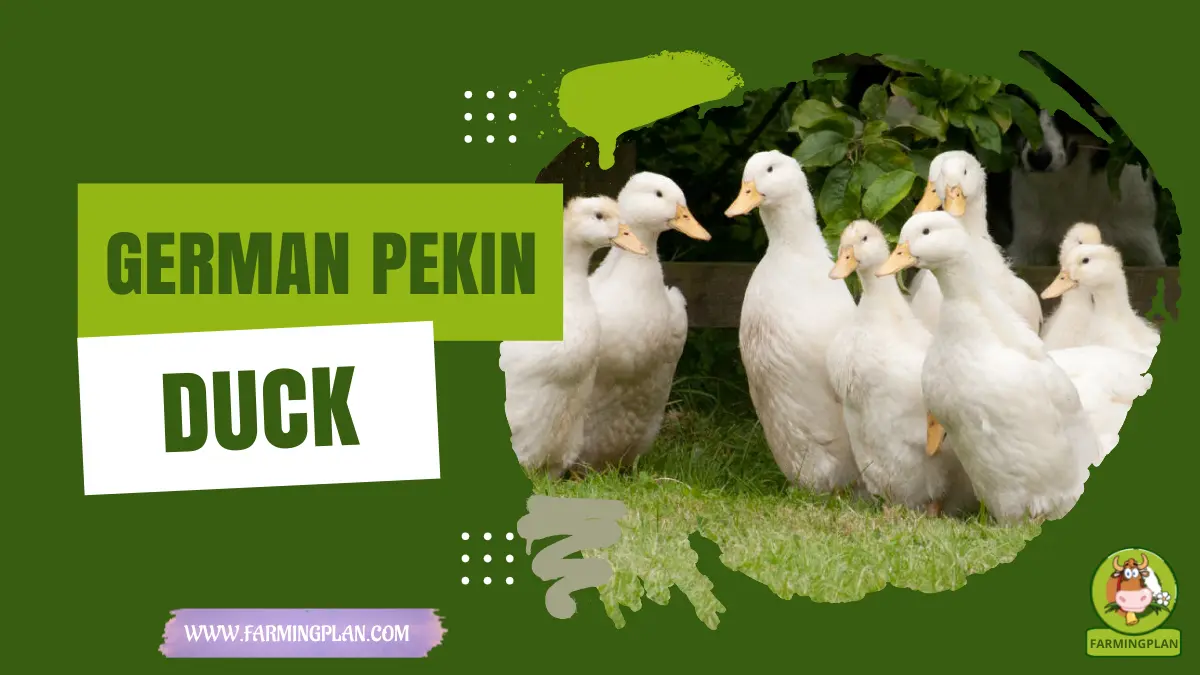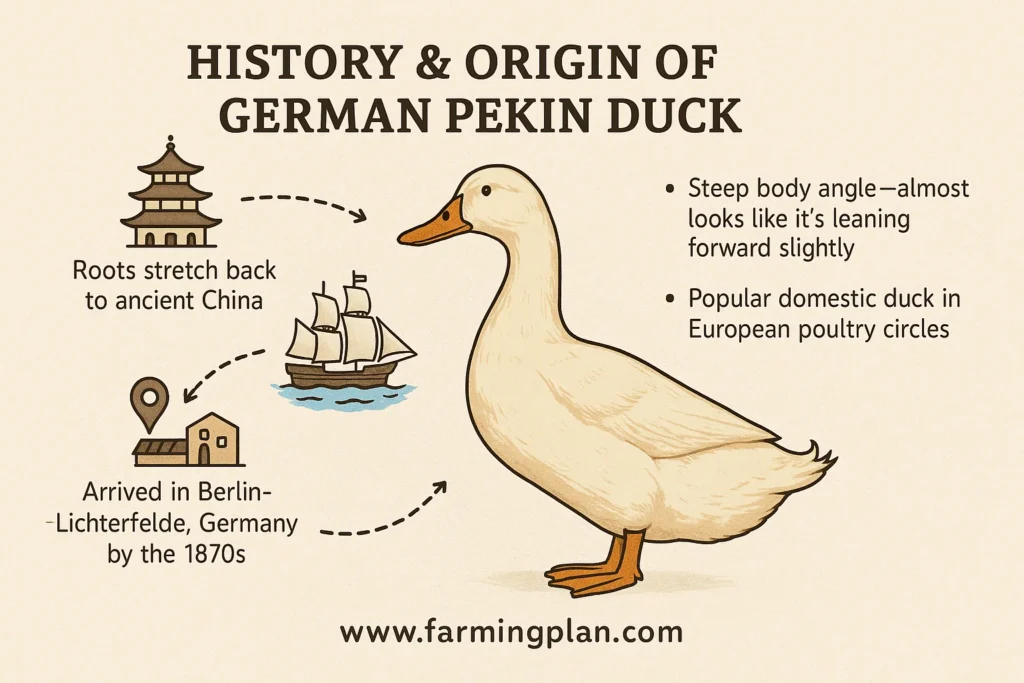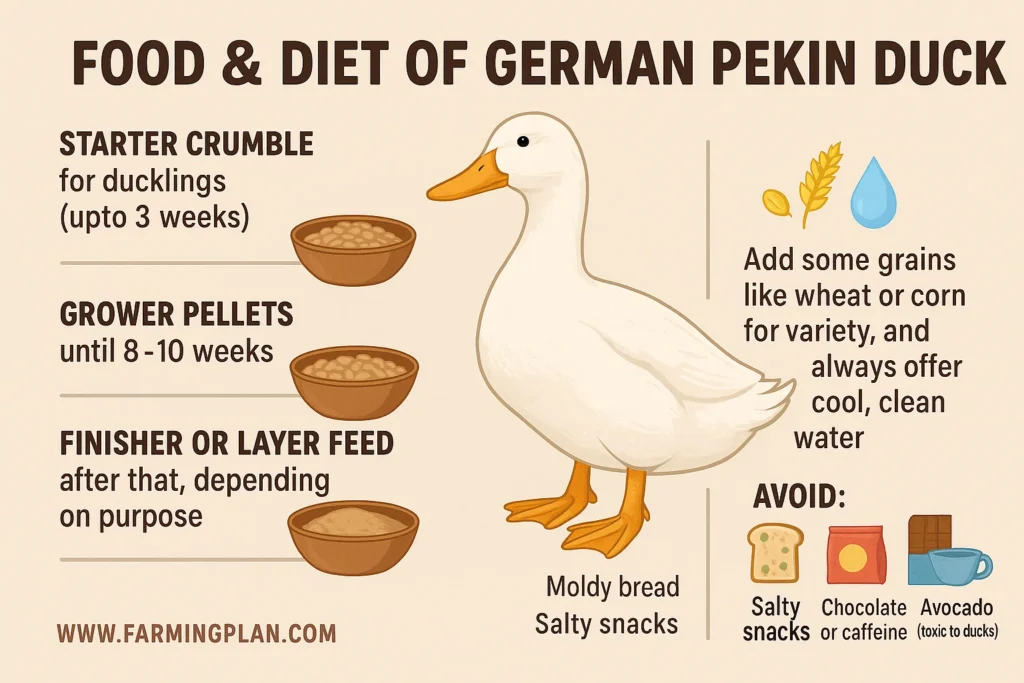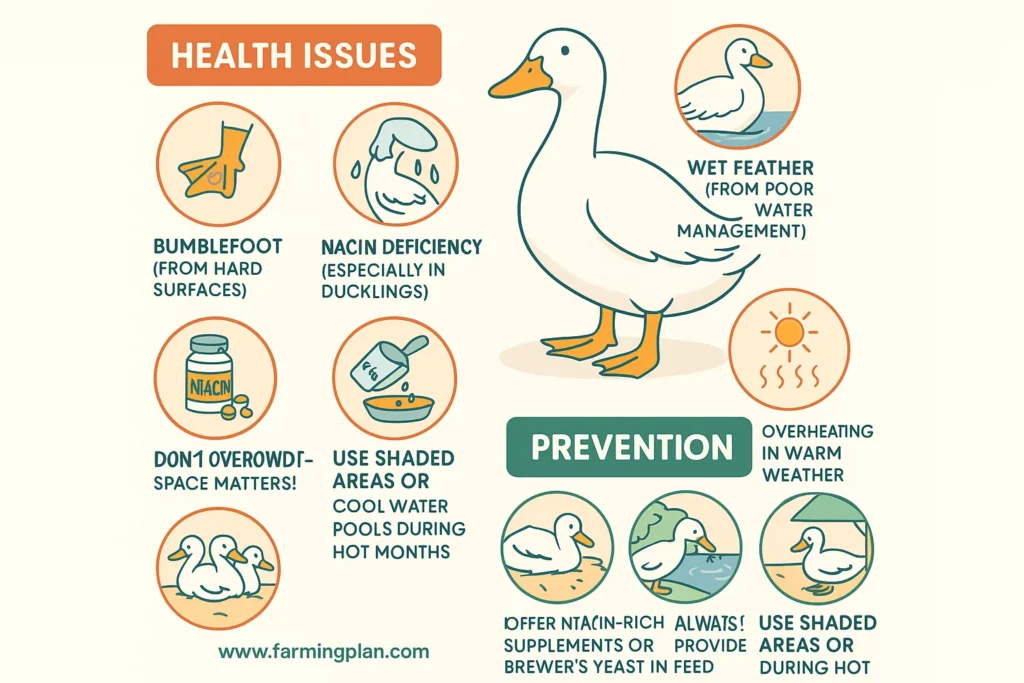If you’re looking for a friendly, hardy duck that brings both charm and utility to your homestead, the German Pekin Duck is a top choice. These beautiful white ducks with bright orange bills and feet aren’t just a pretty sight—they’re also productive meat birds with a calm temperament. Many folks confuse them with the American Pekin or even the culinary “Peking duck” dish, but the German variety is a unique breed with its own backstory and character. Whether you’re a backyard hobbyist, a small-scale farmer, or someone looking for a fun, feathered companion, this bird might be just what you’re searching for.

History & Origin of German Pekin Duck
The German Pekin Duck might be new to some, but its roots stretch back to ancient China. This breed originates from Chinese ducks, which were imported to Europe aboard Dutch trading ships in the 1800s. By the 1870s, they made their way into Berlin-Lichterfelde, Germany, where breeders like Walter Steward worked hard to refine them into what we now call the German Pekin.

What sets the German Pekin Duck apart? Unlike the American Pekin, which stands upright with a vertical posture, the German Pekin has a more steep body angle—it almost looks like it’s leaning forward slightly. This unique feature, along with its strong, hardy nature, impressive feed conversion rate, and wide, meaty body, quickly made it a popular domestic duck in European poultry circles and is still highly regarded today. Even though they share a name and ancestry with the American Pekin, make no mistake—these are separate breeds, bred for different body styles and farming needs.
Read More: Drone Bee: Fascinating Flyers of the Hive
Characteristics of German Pekin Duck
You can spot a German Pekin Duck from a mile away. Their pure white feathers, bright orange bills, and vibrant feet give them that classic duck look. They’re heavy-bodied, broad in the chest, and slightly upright—though not as vertical as their American cousins. Most females weigh around 3.5 to 4.5 kg, while drakes (males) can hit 5 kg or more.
A few noticeable traits include:
- Steep body angle
- Broad chest
- Strong legs
- Curled drake feather on males
- Short neck with proud carriage
This makes them one of the heaviest duck breeds out there—perfect for meat production. They also have clean feathers, and it’s rare to find dark feathering on their bodies, which is a big plus in commercial settings. Overall, the breed is known for its consistent growth rate, good feed conversion, and impressive table bird quality.
Nature & Temperament of German Pekin Duck
Having raised plenty of duck breeds, I can confidently say that the German Pekin always stands out for its gentle nature. These ducks are not just beautiful birds—they’re also fun birds to have around. They get along great with other ducks and even chickens as long as everyone has enough space.
Their calm and curious personality makes them a favorite among pet owners, who often find them waddling over to check things out when they’re sitting on the porch or working in the garden. They’re not aggressive and rarely show dominant behavior. In fact, many pet owners love them for their calm and curious personality.
Whether you’re sitting on the porch or working in the garden, they’ll likely waddle over to check things out. They’re great with kids and don’t mind being watched or lightly handled, especially if you raise them from ducklings. For those thinking of keeping ducks as pets, the German Pekin Duck female is often a top choice due to her docile and steady demeanor.
Food & Diet of German Pekin Duck
Feeding German Pekins is simple, but you’ve got to stay consistent. These birds grow fast and need the right layer of feed or meat bird feed, depending on your goal. I usually feed:

- Starter crumble for ducklings (up to 3 weeks)
- Grower pellets until 8–10 weeks
- Finisher or layer Feed after that, depending on purpose
A big tip? Add some grains like wheat or corn for variety, and always offer cool, clean water—they need it to help swallow and digest their food properly.
Avoid:
- Moldy bread
- Salty snacks
- Chocolate or caffeine
- Avocado (toxic to ducks)
Feed conversion is where this breed shines—they turn feed into meat efficiently. Give them access to a small pool of water for dabbling, and you’ll have happy, healthy ducks in no time.
Usage & Purpose of German Pekin Duck
The German Pekin Duck is mainly a meat bird, and for good reason. It grows fast, has a broad frame, and delivers tender, flavorful meat. Many people compare it to the taste and texture of the famous Chinese roast duck dish but raised ethically and locally. Besides meat, they make excellent homesteader ducks. They help control pests, entertain your kids, and lay a moderate amount of white eggs—though they’re not the most prolific layers out there.
Here’s how folks use them:
- Meat production
- Pet ducks
- Backyard farming
- Ornamental poultry
- Show birds (in European exhibitions)
Because of their docile behavior and gorgeous looks, they’re also great for free-ranging farms and small family plots.
Read More: Castellana Negra Chicken: Bold Beauty Of Spanish Breeds
Special Features of German Pekin Duck
There are quite a few standout qualities in the German Pekin that make them a farmer’s favorite:
- White-feathered for easy plucking (especially good for meat production)
- Broad body and chest for ideal table presentation
- Calm nature makes them easy to raise, even for beginners
- Steep carriage is a visual distinction from American Pekins
- Great feed-to-weight ratio, which means lower costs
- It is an attractive breed for photos, shows, and even royalty-free stock images!
I’ve raised many breeds over the years, and the balance of form, function, and friendliness is what truly sets this breed apart.
“Give A Duck A Pond And A Purpose—And Watch A Happy Farm Bloom!”
Health Issues & Prevention of German Pekin Duck
Like any domestic duck, the German Pekin is generally healthy if raised in the right conditions. But they are heavy ducks, which means they can face leg and foot issues if their living space isn’t well-managed.

Common concerns include:
- Bumblefoot (from hard surfaces)
- Wet feather (from poor water management)
- Niacin deficiency (especially in ducklings)
- Overheating in warm weather
To prevent problems:
- Keep bedding dry and soft
- Offer niacin-rich supplements or brewer’s yeast in their Feed
- Always provide clean water for drinking and dabbling
- Don’t overcrowd—space matters!
- Use shaded areas or cool water pools during hot months.
Regular checkups, clean coops, and plenty of love go a long way in keeping these birds happy and healthy.
Step-by-Step Farming Guide
Step 1: Setup a Comfortable Brooder for Ducklings
Start with a warm, draft-free brooder box lined with straw or pine shavings. I keep the temperature at 95°F (35°C) in the first week, then reduce it by 5°F weekly. Ducklings grow fast, so space matters. Include a duck-friendly feeder, a shallow water container, and non-slip flooring to prevent spraddle legs. Make sure to feed starter crumble with niacin supplements from day one.
Step 2: Move to Grow-Out Pen With Plenty of Space
At about 3–4 weeks, I move them to a larger grow-out pen. It should be secure from predators, well-ventilated, and offer at least 5–6 square feet per duck. Provide grower feed, a small pool or basin for water play, and some grassy patches for foraging. Ducks love to dig around with their bills—let them explore!
Step 3: Daily Care Routine and Clean Water Access
Daily care is simple but important. I feed them twice a day, top off their water, and remove any wet or dirty bedding. Make sure their water containers are deep enough for them to dunk their heads but not too deep for drowning. Clean water is crucial—they use it to clean their nostrils, eyes, and bills.
Step 4: Transition to Adult Feed and Outdoor Living
Once they hit 8–10 weeks, it’s time for layer or finisher feed, depending on whether you want meat or eggs. I allow them to free-range during the day and return to a safe coop at night. Give them access to a small pond, tub, or kiddie pool. Keep the coop dry and well-lit, and watch them thrive.
Expert Tips & Best Practices
- Keep Feed Dry: Wet Feed spoils fast and causes digestive issues.
- Use Kiddie Pools: Easy to clean, safe for dabbling.
- Add Brewer’s Yeast: Great niacin source for healthy legs.
- Handle Often as Ducklings: Builds trust and reduces stress later.
- Raise with a Buddy: Ducks are social animals—never raise just one!
FAQs
What is the difference between German Pekin and American Pekin?
The German Pekin has a more forward-leaning posture and was selectively bred in Germany, while the American Pekin stands more upright and was developed in the U.S.
Can German Pekin ducks fly?
Nope! Like other heavy breeds, they’re too bulky to fly and prefer waddling around.
How long do German Pekin ducks live?
They typically live 5–9 years, depending on care, diet, and environment.
Do German Pekin ducks lay eggs?
Yes, but modestly. You can expect around 100–150 white eggs per year from a healthy hen.
Are German Pekins good pets?
Absolutely! Their calm nature makes them excellent for families, hobbyists, or even schools.
Conclusion
The German Pekin Duck is a strong, beautiful, and friendly bird that deserves more attention in the world of backyard farming and homesteading. With its roots in both China and Germany, it brings a unique history, great temperament, and practical benefits—whether you’re after meat, pest control, or a charming farm companion. I’ve raised them for years, and they’ve never let me down. They grow fast, stay healthy, and bring joy with every waddling step. If you’re ready to add ducks to your life, why not start with a breed that truly does it all?

